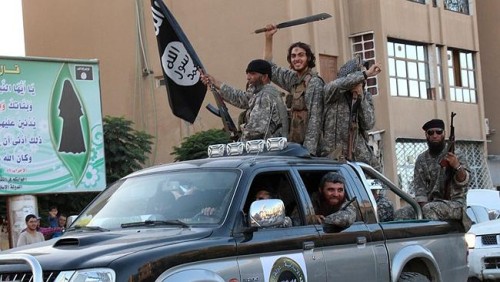The city of Raqqa in northern Syria is the center of the Islamic State’s area of control. Since late 2013, the jihadists have established their political and military authority and a system of governance over the population, estimated at more than 220,000 in 2012.
Omar, a 32-year-old resident, talks to Syria Deeply about the Islamic State’s organization of its rule over Raqqa city and the surrounding towns and villages in Raqqa Province:
ISIS is now working to manifest and enhance its control over broad areas of Syria, the same way they did in Raqqa city. They have divided and distributed authority with precision; they assign job positions among their officials and emirs in Raqqa in a manner that makes it easy for them to rule and apply their own laws, making sure nothing slips out of their hands and that no rebellious act against them could come to life.
At the top, the leadership structure falls under a general emir, or prince, in charge of the whole province of Raqqa and its countryside. The current emir is Awad al-Makhlaf, also known as Abu Hamza. He used to be the emir of the western sector in Raqqa, then he was assigned to be the ruler of Raqqa entirely after the [death] of the previous general emir, Abu Lukman.
Awad al-Makhlaf is originally from Al Mayadin in Deir Ez Zor province in eastern Syria. He was a prisoner in Syria’s Sednaya prison until he was released in 2011 at the beginning of the Syrian revolution. Previously, before the uprising, he used to be an Arabic teacher in a Syrian public school. Later on he participated in many battles against the regime before he joined ISIS when they appeared in Syria last year.
Al-Makhlaf is considered to be one of the most important leaders supporting [Islamic State leader Abu Bakr] al-Baghdadi, and is within his close circle. Under Makhlaf there are other emirs and security officials who have their own jobs and responsibilities in their areas.
In order to manage Raqqa Province, ISIS has divided it into sectors, and each sector into towns and villages. The division of Raqqa province goes as follows:
In the eastern sector the most significant area in it is Madan city, run by Aamer al-Rafedien, a Syrian man from Madan. In the northern sector the most significant area in it is Tal Abiad run by Khalaf al-Hallous, a Syrian man from Tal Abyad. There are other towns in the northern countryside, such as Sallouk and Aien Eissa, but Tal Abyad is considered to be the central town in the northern sector.
In the western sector, the most important area is Tabqa city, run by Abu Huraita al-Jazrawi, a Saudi man. He took over the ruling after the death of the previous Syrian prince, known as Abu Sara, in the recent battles in Ain al-Arab (also known as Kobane). There are other towns like al-Mansoura and Hunaida village, but Tabqa is considered to be the central town in the western sector. And the western sector is considered to be the most crucial sector in this division of Raqqa because it has the Euphrates dam, the Baath dam, Euphrates Lake, and all of the oil wells, which are the most important source of income for ISIS in Raqqa.
For each sector they assigned an emir, and then for each town and each village they assigned other [lower-level] emirs. The [local emirs] follow the emir of the sector, who in turns follows the general emir, the leader of what they call “al-Raqqa State”, its new name under ISIS rule.

